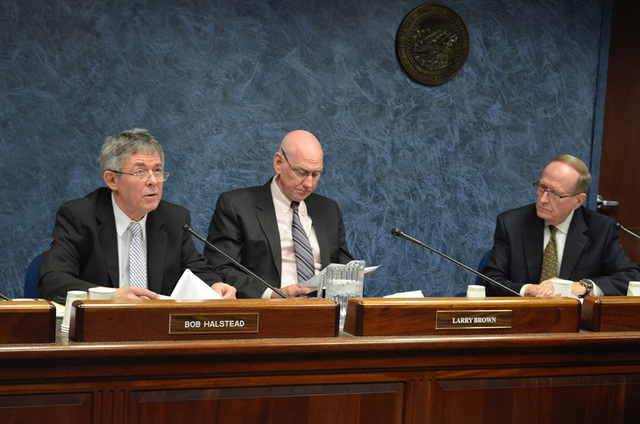
LAS VEGAS – State officials are ready to fight the Nuclear Regulatory Commission’s final supplement to the Department of Energy’s environmental impact statement for a proposed nuclear waste repository at Yucca Mountain.
Nevada Agency for Nuclear Projects Director Robert Halstead said the state is ready to challenge “every conclusion” in the 300-page document before the licensing board.
“On technical and legal grounds, this final EIS supplement is so defective, that if the NRC were about to take final action, we would be going to the U.S. Court of Appeals for the D.C. Circuit in less than 30 days to make them do it all over again,” Halstead said.
The supplement that was released on Thursday evaluated the potential environmental impacts on groundwater and impacts associated with the discharge of potentially contaminated groundwater to the ground surface in the event of a radionuclides release from a repository at Yucca Mountain.
In a preliminary analysis of the document, state officials said the NRC ignored most of Nevada officials’ comments on the draft that was released in August 2015, as it again concluded that the Yucca Mountain impacts on groundwater over one million years would be “small.”
“Our initial review of the final EIS supplement finds that NRC staff have failed to correct any of the major deficiencies we identified in our comments in November, and if the NRC were about to take a final agency action based on this document, we would have grounds for an immediate legal challenge,” state officials said in a statement.
Halstead said the evaluation of impacts on Native American tribes is especially deficient.
“For example, the NRC added some map information as we suggested, showing the contamination plumes reaching the springs at Furnace Creek, under the no pumping at Amargosa farms future scenario, but their map does not include the Timbisha Shoshone trust lands near Furnace Creek, which are potentially impacted, or the tribal lands near Death Valley Junction,” he said.
Officials discussed the final supplement at the Nevada Commission on Nuclear Projects meeting on Tuesday. The event brought Nye County, state officials and several affected parties, including tribal members to the Grant Sawyer Building in Las Vegas.
Ian Zabarte, a member of the Western Shoshone tribe and board member of the Native Community Action Council that stands in the NRC’s licensing proceedings, said the NRC didn’t “sufficiently” address the Western Shoshone health and environment.
“The government of Newe Sogobia does not consent to be a global sacrifice zone for the disposal of high-level nuclear waste from the world. We reaffirm opposition to U.S. violation of the territorial integrity of Western Shoshone domain as identified by the 1863 Treaty of Ruby Valley,” Zabarte said in a statement.
Darrell Lacy, director of the Nye County nuclear waste project, said the final supplement is consistent with past findings such as the Safety Evaluation Reports where the NRC staff found that Yucca Mountain could be built and operated safely.
“The next step would be licensing for the Yucca Mountain design,” Lacy said. “If Congress decides to provide funding for the licensing process, we hope they provide the needed funding for Nye County and the other local and state agencies to participate.”
The DOE previously declared the site “unworkable” and declined to go forward with the project. Halstead said the NRC is down to $1 million-to-2 million in Yucca Mountain funds and will need at least $330 million for full licensing over three-to-five years.
U.S. senators Harry Reid and Dean Heller have long opposed new funding for the licensing of Yucca Mountain. In recent months however, several U.S. Congress members renewed their call to restart the licensing process. On April 19, the House Appropriations Committee adopted a fiscal year 2017 appropriations bill that provides $150 million for the nuclear waste disposal program and $20 million for the NRC to continue the adjudication of DOE’s Yucca Mountain license application.
The bill also includes $5 million for affected units of local government (AULGs), 10 counties that are located in the nearest proximity to Yucca Mountain and would conduct oversight and participate in the licensing process, if the nuclear waste repository moves forward.
A plan to permanently store 77,000 tons of nuclear waste in Yucca Mountain was mothballed by the Obama administration in 2010. The NRC restarted work on the DOE’s license application to build and operate a repository because of a 2013 federal appeals court decision.
The state’s technical experts and legal team will prepare a detailed analysis of the final EIS supplement during the next 90 days, officials said.
Contact reporter Daria Sokolova at dsokolova@pvtimes.com. On Twitter: @dariasokolova77